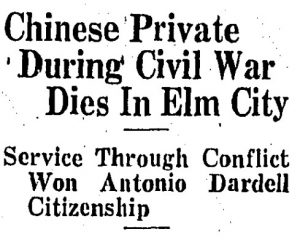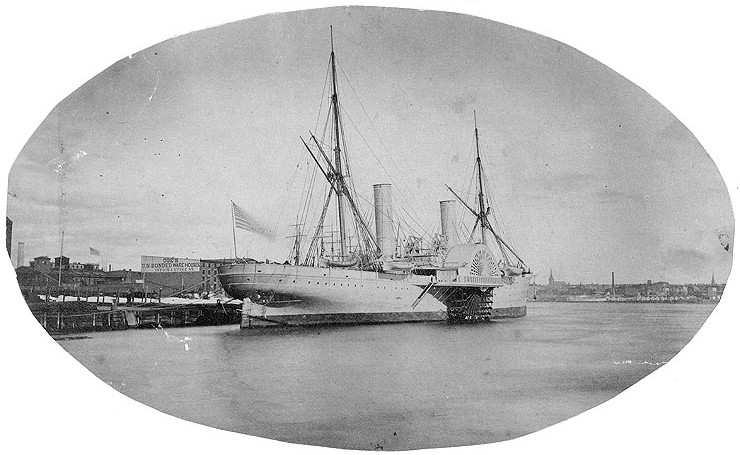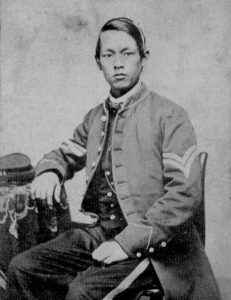By Nancy Finlay
While oversimplified narratives about the American Civil War often reduce it to a simple conflict involving the binary classifications of Black and white, not all the participants in the war can be neatly categorized as such. An often underappreciated story involves the substantial number of young men from China, Southeast Asia, and the Pacific who signed up to fight in the War between the States—many of whom served in Connecticut regiments or signed on in Connecticut ports to serve on naval vessels.
Chinese and Southeast Asian Soldiers in Connecticut
Joseph Pierce enlisted on July 26, 1862, and mustered into the 14th Connecticut Volunteer Infantry, which became part of the Army of the Potomac. Despite his English name, Pierce was born in Canton, China in 1842. His father sold him to an American sea captain who brought Pierce to Connecticut where he grew up on a farm in Berlin. Following the Battle of Gettysburg, his superiors promoted him to corporal, making him the highest-ranking Chinese soldier in the Union army. Pierce also fought at Antietam and took part in the Grand Review of the Army in Washington, D.C., following Lee’s surrender at Appomattox. He mustered out on May 31, 1865. After the war, Pierce settled in Meriden, married an American woman, and worked as an engraver for the Meriden Britannia Company.
Like Joseph Pierce, Antonio Dardelle was brought to Connecticut from China by an American sea captain. After growing up in Clinton, he enlisted in the 27th Connecticut Volunteer Infantry for nine months and served from October 22, 1862, to July 27, 1863. Injured in the Battle of Fredericksburg in December 1862, by January 31, 1863, Dardelle was in a hospital in Portsmouth, Rhode Island, recovering from his injuries. After the war, he lived in downtown New Haven where he worked as a tinsmith. Unlike Pierce—who does not appear to have joined any veterans’ organization—Dardelle faithfully attended his regiment’s annual reunions and played an active role in Republican politics. Pierce and Dardelle both served with “white” regiments, an assignment not applied universally to all Asians in the army.

Antonio Dardelle’s obituary in the Hartford Courant, 1933 – Hartford Courant, Connecticut State Library
Connecticut formed its first Black regiments following the Emancipation Proclamation in 1863, and these, too, contained soldiers born in Asia and the Pacific islands. John Banks, a dark-skinned laborer from Bridgeport who was born in the East Indies (historic term for most of Southeast Asia) in 1843, enlisted in the 30th Regiment of Connecticut Colored Infantry on February 4, 1864. Daniel Newport, also from the East Indies, joined the 29th Connecticut Colored Infantry on August 31, 1864. John Lodigo, who was born in China, enlisted in the 31st Colored Infantry in New Haven on December 12, 1864 and deserted seven months later in July 1865. A native of the Sandwich Islands (as Hawaii was then known), Peter Johnson, enlisted in the 29th Connecticut Colored Infantry in Bridgeport on April 18, 1864, and died in the hospital at Point of Rocks, Maryland, on January 9, 1865.
Connecticut Sailors from Hawaii
While no records of Chinese men serving in the navy have yet emerged, two young men from the Sandwich Islands signed on as naval recruits in Connecticut. Manuel Flores, who gave his place of birth as Honolulu, enlisted for three years in the United States Navy in Bridgeport on August 14, 1862. John Manuel enlisted in New London on September 8, 1862. Flores’s race is listed as “mulatto” and Manuel is identified as a “negro,” but both were probably either ethnic Polynesians or possibly Black Portuguese mariners from the Cape Verde Islands. Manuel served on the U.S.S. Vanderbilt and probably took part in the search for the Confederate raider Alabama.
Locating Asian and Pacific Islander Soldiers in Historical Records
During the Civil War, the ethnic origins of many Chinese, Southeast Asians, and Hawaiian men were concealed by their English—or at least European-sounding—names. Even the records that indicate a soldier’s race only provide clues about their identities as there were no widely accepted terms at the time for “Asian” or “Pacific Islander.” The best indicator of ethnicity is often place of birth, but even this can be inaccurate or misleading as in the case of two men with Hispanic names who claimed to have been born in Hawaii. Lacking other evidence, the military assumed most of these soldiers and sailors to be either Caucasian or African American, like so many of their comrades. Fortunately, for a few individuals, substantial documentary evidence of their true origins does exist—allowing a glimpse into the stories of these remarkable young men.
Nancy Finlay grew up in Manchester, Connecticut. She has a BA from Smith College and an MFA and PhD from Princeton University. From 1998 to 2015, she was Curator of Graphics at the Connecticut Historical Society.










